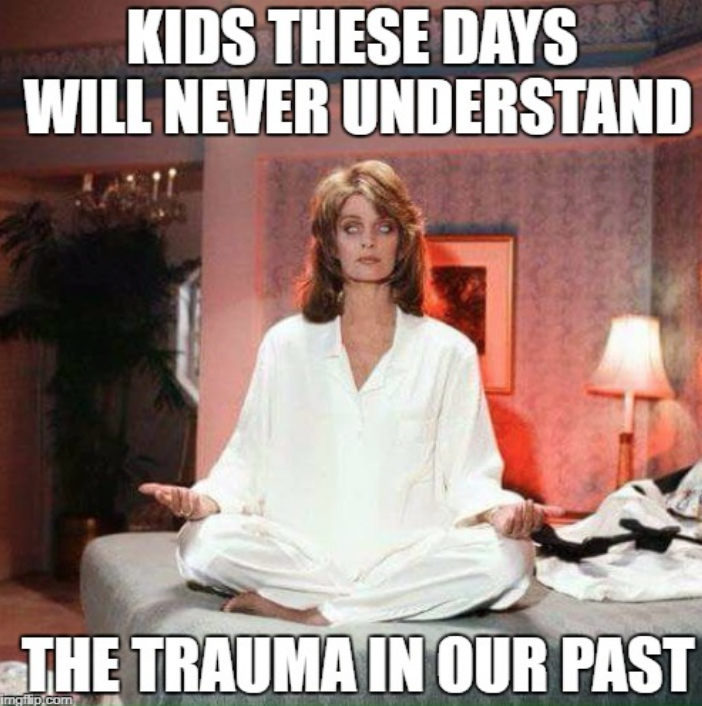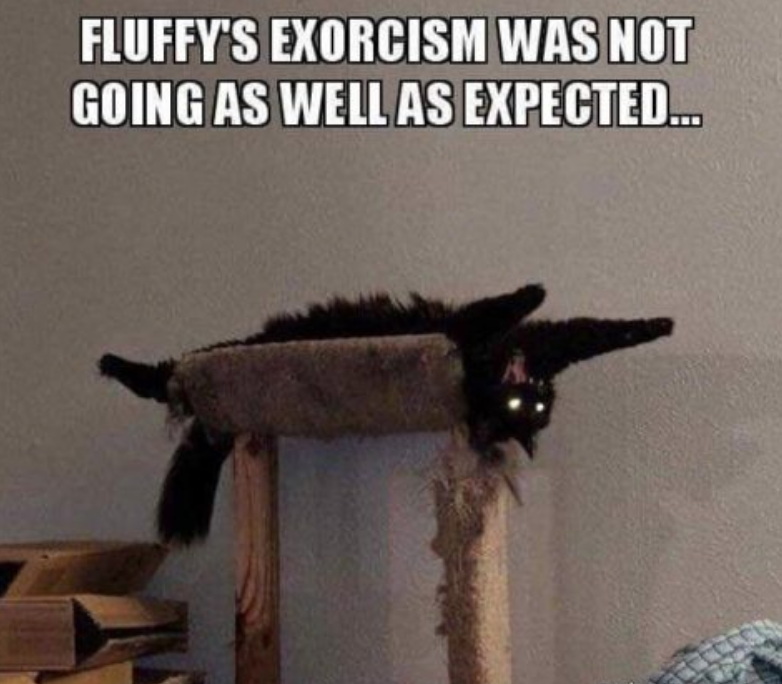
Inner demons can be one of the toughest concepts for new (and even not-so-new) authors to grasp. Yet, inner demons are essential to create a riveting story that connects with the audience.
Frankly, characters with no blindspots or baggage are B-O-R-I-N-G.
Bad decisions make great stories.
We humans tend to resent perfect people and, instead, connect more intimately and authentically via shared flaws. Audiences love rooting for their favorite character to overcome his weaknesses and come out the other side better and stronger than when the adventure began.
It’s like when they win, we win.
Without this internal angst, a story falls flat and characters become forgettable, interchangeable plot puppets.
In all my years working with writers, one of the greatest weakness I’ve witnessed is that new writers mistake melodrama (soap opera drama) for story drama.
Yes, this really is related to inner demons.
Melodrama works well for soap operas, but spells death for a novel.
Soap operas don’t require a solid core story problem with definitive structure…just great hair, fabulous makeup, and a cast with more issues than every Dr. Phil guest combined (and little or no interest in getting rid of those issues).
In soaps, it is perfectly acceptable to point out personal demons with neon lights.
Why? Because while problems are constantly being talked about (via fights, gossip, confessions)…nothing is ever fully resolved.
Ever.

And I am in no way dissing soap operas. There’s a good reason they’ve lasted as long as they have. Come on, Days of Our Lives has been around since 1965.
Yet, this type of storytelling is designed to hook in a very superficial way. Also, what audiences will tolerate in a television show will drive them bonkers in a book.
STOP TELLING ME THINGS I ALREADY KNOW!
NOTHING IS HAPPENING!
*primal screams*
In soaps, the characters have personal demons, but not really INNER demons. If the demons are obscured (as is necessary in a novel) then audiences couldn’t miss two…ten years of episodes and yet still be able to catch up in a week.
This is why there’s a lot of ‘As you know, Bob’ dialogue. The repetition is there to help anyone who’s missed some episodes to get back on track with the show.
Soap Opera writing is designed to be overt.
Storylines are crafted to keep going on and on with only enough ‘closure’ to introduce a new hook (evil twin, amnesia, insider trading, hostile takeover, murder, infidelity….*looks to drop-down menu*).
Novels, on the other hand, don’t have the luxury of rambling on for decades. Unlike soap operas, novels have to actually end.
***Wow, the things I learned with my first novel.
This means we (the author) must introduce a core problem (early) that we’ll resolve—fully or at least satisfactorily—by the final page.
Sudsy Demons

Why am I bothering to talk about soap operas? Because I see A LOT of soap opera writing in new manuscripts, and I want y’all to understand why this style works on screen but not in novels.
In soap operas, it’s perfectly acceptable for a character to wax rhapsodic about his or her personal demons in cheesy monologues.
It has to do with the medium.
Soap operas got the name ‘soap operas’ because the stories were originally created for housewives to listen to when doing the wash or cleaning.
Initially, these stories played on the radio, but the storytelling style didn’t change much even when soaps shifted to television.
Writers scripted stories and dialogue in such a way that the audience didn’t have to be LOOKING at the screen to keep up (which is why you’ll notice there are a lot of characters calling one another by name which—in life and in a novel—is plain weird).
‘As you know, Anastasia, the reason Fabio and I had to run away to Cabo is because Dr. Fandango has been hiding the fact that Fabio has multiple personalities. And yes, I confess. I helped Fabio escape Dr. Fandango’s facility. Why? Because Dr. Fandango refuses to admit he’s my biological father. I know abandonment, Anastasia. And I want Dr. Fandango to know it, too….’
*dramatic music here*
As a Texan? I LOVE me some Telemundo. Telenovelas are da BOMB! Everything is over the top, and even though my Spanish skills are rudimentary at best, I can become easily addicted in ONE episode…

Unless We’re Writing Episodes of As the World Turns…
We’ll need to deliver those personal demons with a little—okay a LOT—more finesse. We can’t be as blatant or the story will be…um, weird.
This means we must have a solid plot because the problem with inner demons is they are, well…inner. The author’s job then, is to draw the demons out (via a STORY PROBLEM) so they can be overcome.
Plot and structure is how we do that.
Did I Mention Inner Demons are INNER?

Many new writers begin their ‘novel’ with a character doing a lot of internalization and thinking and thinking and more thinking and pondering over personal issues.
That, or the MC is fully self-actualized and well aware of his/her ‘issues’ and talks about them…a lot.
This is problematic for a number of reasons.
First, the entire POINT of the story problem is to shove the MC out of their comfort zone and into a place where he or she has no choice but to face the inner demons or LOSE BIG.
When we begin a story with an MC who’s already fully aware of his shortcomings, this character will quickly grow tedious and ring false. This is also a formula for a character readers will HATE.
How many of you LOVE people who KNOW they have a problem, but still do dumb crap anyway?
What, no takers? Thought so.
Secondly, revealing inner demons too early—and spelling them out in Crayon—spoils the mystery/adventure. Part of what readers love about a good story is that, like a therapist, we see what the MC’s issues are long before they do.
The main reason we turn pages until three in the morning is we want to find out if the MC figures out their problem before it’s too late.
Thirdly? When we introduce the story with inner demons—our MC droning on about emotional damage—it is too SOON. We (readers) just don’t care.

Nothing personal, but we have our own problems. We don’t have the time or energy to give a fig about a stranger’s drama.
The story problem is what hooks us and makes us care. So about these inner demons, remember…
Demons Hide in the Blind Spot

One key thing to remember about inner demons is they hide really, really well. If they didn’t, then shrinks would starve and be treated like writers.
Wow, you’re a psychotherapist? Really? What’s your ‘real’ job? Seriously, people PAY you to listen to their problems?
This is another reason we don’t begin with a protagonist thinking about her inner demons. Odds are, she is oblivious they are even there. She isn’t yet that self-actualized.
Denial is more than a river in Africa.
In fact, the stronger the denial, the better the story (or, if you’re a therapist, the better the $$$$$). This is why your protagonist, if pitted against the antagonist in Act One, should lose. He/She has not grown enough in order to defeat the core story problem
Plot is What Exorcises the Demons

The plot is the crucible that will fire this demon to the surface so the character can then defeat it. This is why understanding plotting becomes so vital. A great plot problem is going to sprout directly from that inner demon. Why?
Because fiction is the path of greatest resistance.
What good is a plot problem unless it pits the character against her deepest flaw?
Some weaknesses might be fairly obvious—grief, betrayal or addiction. The problem, however, is no one wants to read 300+ pages of someone whining about a loss or a compulsion. We would probably want to smother such a person to get her to shut up.
Whining is not a plot.
Also remember that there is a reason for the grief, feeling of betrayal or addiction, and THAT is the real inner demon that must show its head.
There has to be an outside challenge that forces the character to eventually choose to remain the same or to evolve (Act III).
You gonna keep hiding in a bottle? Or are you gonna face/defeat WHY you drink so you can walk your daughter down the aisle?
Not all inner demons are as obvious, though. In fact, the tricky demons can look a hell of a lot like our greatest strengths.
Remember that every character strength has a corresponding weakness.
***For a SUPER efficient way to find interesting blind spots, check out Angela Ackerman and Becca Puglisi’s AMAZING Positive Trait Thesaurus. There’s also the Negative Trait Thesaurus. I recommend you just treat yourself and buy the entire collection. You’ll thank me later.
Anyway, inner demons can be a real bugger to spot because these ‘strengths’ have served the character really well (or at least the character believes they have).
In fact, these inner demons might be the very reason the character has always been successful…until you (Evil Author Overlord) hand her a problem where the old tools no longer work.
New level, new devil, baby 😉 .
Willingness to work eighty hours a week is fabulous for climbing the corporate ladder, but what about keeping a marriage together?
Hmmmm….
Positives Can Be Negatives

Let’s say our imaginary protagonist has a heart of gold. We’ll call her Helpful Hanna for today’s purposes.
HH is always there to help a friend, lend an ear, or fix a problem no matter what. Helping is the core of her identity.
But what happens when, one day, she has the chance to pursue her dream?
She decides to open her own cupcake bakery (but over time) will come to realize that she’s spending so much time helping other people that her bakery’s doors might never open.
If she’s rescuing others at all hours and no matter the inconvenience, how long until she crumbles under the pressure?
Before her cupcake bakery dream, she had the luxury of bending more than the karma sutra to lend a hand.
The plot, however, forces her to finally see that others are actually using her. She might even realize that she wasn’t helping after all…that she was really enabling or even controlling.
Maybe those around her never expected her to constantly help and would actually love a chance to give back to her for a change.
*mind blown*
Hannah must eventually choose.
Eventually, the story should force Hannah to a crossroad—either she can do all the things for all the people, or she can have her dream.
But she cannot have both.
The pressure is what makes Helpful Hanna acknowledge her inner demon and face what’s really driving her compulsive need to help.
Perhaps Hannah’s ‘helping’ is more about power, control, or being ‘needed.’ Could be a lot of things.
When the outside challenge—opening a cupcake bakery—reveals the cracks in Hannah’s core identity, what will she DO?
We answer this question in Act Three.
See, before Hannah had a dream of a cupcake bakery, she could be there for everyone, anytime and all the time.
The plot problem (in the form of a dream), however, drives the demon to the surface and our MC has to learn or lose.
Notice how the problem (outside goal) helps this become a story, not just 300 pages of tedious navel-gazing. We show Hannah has a problem, then show her realizing she has a problem, and then show her overcoming that problem.
Flawed People Make Fabulous Fiction

In the end, remember that inner demons make a better story. And not every book requires some huge, over-the-top trauma.
My entire planet was wiped out, and I am the last of my kind.
Yeah…ok. I got head lice in third grade. Was super embarrassing.
In fact, those ‘smaller’ demons—sibling rivalry, abandonment, false shame, false guilt, family expectations—can be far more resonant because the audience can relate.
What are your thoughts? I LOVE hearing from you!
Did you struggle with soap opera drama early on in your writing? I know I did. Hey, there is a LEARNING curve to this.
Have you ever been hooked on a soap opera? Which one?
In college, I made fun of my roommate for watching Days of Our Lives and would pick on her during the show. A week later? I was changing my class schedule so I could find out if Bo and Hope were EVER going to get back together.
*hangs head in shame*
Do you feel a little better about plot? Does it make it simpler to see that the ‘inner demons’ don’t have to be huge to be HUGE?
Heck, I still need therapy for the dumb stuff adults said to me when I was a kid.
Too bad you aren’t as pretty as Such-And-Such.
Or as an adult.
You’re a writer? How cute. Well, your cousin—the one who married the astronaut—just gave up fashion modeling to cure cancer. Isn’t that fantastic?
*screams*
Surely I am not the ONLY one from a jacked up family. Feel free to share!
…really.
Anyway…
Just FYI, I’m extending the CLEARANCE sale a little longer, until new classes begin. We need to test the new Event Espresso license and this site’s functionality (we’ve updated everything). If you need a good plotting or character class, NOW is the time to get it.
I have to free up space on our servers. All my classes are detailed and average 2-3 hours. These are On Demand classes you can watch at your leisure and have fun while you learn (for classes, scroll down).
This not only is to help you guys get the training you need (affordable summer school), but it will open up room for the new recordings of new classes.
Please take advantage of the sale! I rarely drop prices this low.
After July 17th, these classes will no longer be for sale (and will be slated for deletion).
Some, I will offer again later in the year. Others? I won’t be offering again the same way (will be likely splitting them into two classes because they ran long).
Thanks so much for your support!
ON DEMAND CLEARANCE ON BRANDING & CRAFT CLASSES!
Available until July 17th, 2019
CLEARANCE Branding, Social Media & Sales Classes
ON DEMAND T.K.O. BUNDLE: Branding, Blogging & Sales for Authors
$99 (Regularly $165)
ON DEMAND Brand Boss: Branding for Authors
$35 (Regularly $55)
ON DEMAND Sales for Writers: Sell Books Not Your SOUL
$35 (Regularly $55)
ON DEMAND Blogging for Authors
$35 (Regularly $55)
Also Offering:
ON DEMAND Social Schizophrenia: Building a Brand WITHOUT Losing Your Mind
$35 (Regularly $55)
CLEARANCE Craft Classes
Plot Boss: Writing Books Readers Want to BUY!
$35 (Regularly $55)
Fiction Addiction: The ‘Secret’ Ingredient Readers Crave
$35 (Regularly $55)
Story Master: From Dream to DONE
$35 (Regularly $55)
The Art of Character: Creating Dimensional ‘People’ in Fiction
$35 (Regularly $55)
Beyond Bulletproof Barbie: Creating Strong Female Characters for a Modern World
$35 (Regularly $55)








10 comments
4 pings
Skip to comment form
I clicked on this class: ON DEMAND Sales for Writers: Sell Books Not Your SOUL, but the link says the event expired.
By the way, I used to be hooked on The Young and the Restless. Watched that show for probably 20 years before I finally cut the cord (I would record it and watch it when I got home from work). It was almost a relief when I stopped, too. It was starting to take over my life!! 😀
Author
I’ll fix it. Thanks!
Author
It’s fixed. SEE? This is why I extended the sale, to work the bugs out. Thanks for the heads up!
Thank you for this post, it helped a lot! And I was a Days of our Lives – Another World – Guiding Light kid ?
Thank you for the realistic example to help me follow this lesson. (And now I need a cupcake!) DOOL fan from back in the day and I remember when Hope was just a little girl with Doug Williams as her daddy. My times change.
Sometimes I wonder if we get too caught up in trying to keep our reader enthralled when we should be working on telling a good story. What I mean is we get thrown down by trying to show flaws, positives, and negatives, and let the story go on by itself–or not go on at all. If we just let the characters be who they are, and that does include the flaws, positives, and negatives, and get on with the story, maybe the whole thing would be fantastic.
Author
That seems very simple but it isn’t. Too many writers fixate on pretty sentences and aren’t telling a story. Every character is perfect and I get samples that are page after page of drinking, eating, shopping, and two characters talking about a third. The pages drone on repeating what I’ve already been told. The entire point of this post is that writers AREN’T telling stories. They’re having bad situations and that is a soap opera,. not a novel.
Patrick Melrose; Ed St. Aubyn. Keeps you hooked because you want to know if he’ll pull through or wind up in a gutter. Good book to study.
Thank you for this post! It came at the exact right time. I’m currently writing something where, unbeknownst to what the actual slippery slope I’m trying to manage was, i now know what the trap is i need to remain aware of at all time.
My favourite soap for the longest time was Neighbours.
Love the part about demons sometimes looking like strengths. That can be a very strong writing way of drawing in the reader.
[…] saw a similar explanation in this blog post by Kristen Lamb. “Audiences love rooting for their favorite character to overcome his weaknesses and come out […]
[…] or just ‘scene’ after ‘scene’ of bad situations? This is what I call ‘soap opera writing. There is no core story problem to be resolved by the end of the […]
[…] Inner Demons: Soap Opera Drama vs. Story Drama […]
[…] in fiction. The kissing cousins of the lie—deception and betrayal—can summon some horrible private demons. Demons so highly effective that solely the crucible of a powerful story downside can exorcise them […]